Adam Yamey's Blog: YAMEY, page 26
January 25, 2025
Going Dutch in the fort at Golconda
WHILE VISITING THE RUINS of the fort of Golconda near Hyderabad (India), my eyes fell on an old cannon lying beside a footpath. I stopped to examine the markings on the disused artillery piece, and noticed it bore a logo consisting of the interlocked letters V, O, and C. I recognised that this was the logo of the Dutch East India Company (‘Vereenigde Oostindische Compagnie’: ‘VOC’). I wondered why it was at the fort.
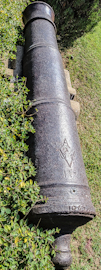
I knew that the VOC had had trading stations along the Hooghly River in Bengal (eg at Chinsura and Cossimbazar) and Gujarat (Surat), but until today (21 January 2025), I was unaware that the Dutch had factories (trading stations) in Telengana and Andhra Pradesh: in what was once the Sultanate of Golconda. The ruined fort was in the Sultanate’s first capital, Golconda, between 1519 and 1591, and then the capital was moved to nearby Hyderabad (capital from 1591 to 1687).
The VOC had factories along much of the Coromandel Coast (the east coast of south India). The first of these was established at Pulicat (Tamil Nadu) in 1613. In 1634, they opened a factory in Golconda, where there were many diamonds and other wares worth trading. The Dutch Golconda factory continued until they abandoned it in 1733 when local disturbances made the enterprise unprofitable.
Having learned about the Dutch trading post at Golconda, I begin to understand why there is at least one cannon with the VOC logo in the Golconda Fort archaeological site. Had I not noticed this logo while walking along, I might have remained ignorant of the former Dutch presence in what is now the Indian State of Telengana.
January 24, 2025
No guide, no happy
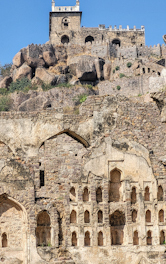 Partvif Golconda Fort
Partvif Golconda FortTHE GOLCONDA FORT near Hyderabad was constructed between the eleventh and sixteenth centuries. It fell into disuse and ruin in 1687. This extensive ruin is very impressive. On arrival, and even after entering the protected archaelogical compound, men offer their services as guides. Employing one of these is unnecessary because the different parts of the fort each have their own information panels with English translations.
When we were approached by one of the guides, we declined his services, and he told my wife (in Hindi):
“Take guide, please your husband.”
On hearing our refusal, another man offering to be our guide said (in English):
“No guide, no happy.”
January 23, 2025
A palace that was in Pakistan for less than two days
IN 1904 THE WASIF Manzil, a palace in Murshidabad (West Bengal, India) was restored after an earthquake had badly damaged it in 1897. The palace was built for Sir Sayyid Wasif Ali Mirza Khan Bahadur (1875-1959), who became Nawab of Murshidabad in 1906. It was designed by a Britisher, Mr Vivian, and a Bengali engineer, Surendra Barat. This pleasant building is a mixture of architectural styles and includes some turrets with crenellations.
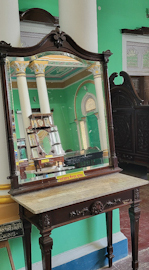
Visitors can explore the interior of Wasif Manzil, which now contains a museum. The exhibits include several wooden framed mirrors, which were imported from Belgium. There are also some glass topped display cases containing dust covered documents, several of which have obsequious addresses to Queen Victoria and some of her royal successors. By the time that Wasif Ali Mirza was living, Indian royalty was very much at the beck and call of the British rulers of India. It was in their interest to appear to be loyal supporters of the Imperial rulers of India.
On the fifteenth of August 1947, when land was divided between the newly formed Pakistan and independent India (by Cyril Radcliffe who only visited India for the first tine in 1947), Murshidabad was allotted to Pakistan: it became part of East Pakistan (https://en.m.wikipedia.org/wiki/Murshidabad_district).
Thus, the Wasif Manzil stood on Pakistani territory. However, less than two days later, there was a territorial land swap: Murshidabad, then in Pakistan, was exchanged for Khulna, then in India. Thus Murshidabad became part of India and Khulna became part of East Pakistan (now Bangladesh).
Because of a brief period in the second half of August 1947, the Wasif Manzil was in Pakistan for less than two days.
January 22, 2025
A DISH OF RICE AND MEAT IN HYDERABAD AND ELSEWHERE
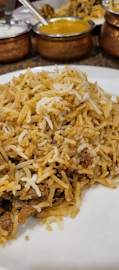
HYDERABAD IS FAMOUS for its biryanis. One restaurant that is well-known and highly rated is Shadab, which is not far from the Char Minar in the centre of the old city. We have visited it on previous visits to Hyderabad and thought highly of its biryanis. Today, in late January 2025, we ate a mutton biryani. It was certainly very good, but not nearly as excellent as one we ate in Surat last year and another we ate at Berhampore (West Bengal) a few days ago. However, the best biryani I have eaten to date was a Moplah style biryani served at Paragon in Calicut (Kerala). Blending Arabic and Keralan flavours, this biryani, which we ate more than 20 years ago, was memorably fragrant and tasty: a symphony of flavours.
January 21, 2025
Almost nothing remains, but this palace and its owner have not been forgotten
ALL THAT REMAINS OF A MAHARAJAH’S PALACE … IS ONLY A FEW ARCHES.
Not marked on Google maps, but mentioned in a guidebook to Murshidabad (in West Bengal), this remnant of a palace is extremely difficult to find. Our toh-toh (electric autorickshaw) driver asked many locals for directions. To my surprise, all knew about the small remains of a former palace, once a home of Maharaja Nanda Kumar (1705-1775), a tax collector for the British East India Company [see: https://en.m.wikipedia.org/wiki/Maharaja_Nandakumar ], who fell foul of the Company’s law. The guidebook did not mention this or the fact that he, a friend of Warren Hastings, was hanged by the Company for alleged fraud.
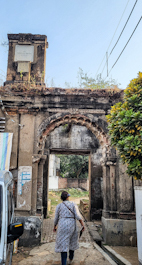
January 20, 2025
Mrs Warren Hastings and a diamond dealer in Bengal
AS EARLY AS THE SEVENTEENTH century, the French, Dutch, and English set up factories (trading stations) at Cossimbazar, which is beside the Hooghly River in the north part of West Bengal. It existed before what is now Murshidabad became capital of Bengal. Today, what was once an important trading centre, where European merchants acquired goods to bring from India to Europe, is now no more than a rustic village.
Cossimbazar is home to a small cemetery, the Old English Cemetery, which contains the graves of about 30 Brits who died between 1730 and about 1800. Within this small graveyard, which is maintained by the Archaeological Survey of India, there is one above the burial place of Mary Hastings and her young daughter Elizabeth. The gravestone has been restored and is legible.
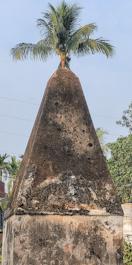
Mary, who died in 1759 (as did her daughter), was the first wife of Warren Hastings (1732-1818). He was a senior British East India Company administrator: the first governor of the Presidency of Fort William (Bengal), the head of the Supreme Council of Bengal, and so the first governor-general of Bengal in 1772–1785. He lived in Cossimbazar for a short time.
While reading about the Old English Cemetery, I discovered that it contains the grave of a successful Jewish merchant from London: Lyon Prager (died at Cossimbazar). Born in 1746, he died suddenly in May 1793. In brief, as an article (www.telegraphindia.com/culture/diamonds-and-dust-the-backstory-of-a-forgotten-grave-in-murshidabad/cid/1889965) revealed:
“Prager had come to Calcutta in 1786 on behalf of a London firm of Israel Levin Salomons, an Ashkenazi Jew. Diamonds were just one of the things Salomons traded in his India business; pearls and drugs were others.”
Stones cut in Benares by experts from Gujarat were sent down the Ganges to merchants and traders at Cossimbazar and other places further down the Hooghly. Most probably when Lyon Prager took ill at Cossimbazar he was there for undertaking business dealings.
Unlike Mary Hastings’s gravestone, the writing on Prager’s is now illegible. I have seen a photograph of his monument that is surmounted by an obelisk, which was taken when the grave was still identifiable. Without knowing that it was Prager’s grave, I photographed it when we visited the cemetery in January 2025.
When I was researching my book about Jewish migration to South Africa, I learned that the Dutch East India Company did not permit Jewish people to travel to their trading stations in the Cape of Good Hope and elsewhere unless they had converted to Christianity. The presence in India of a Jewish trader, such as Lyon Prager suggests that in the eighteenth century, Jews were not barred from joining trading expeditions by the British East India Company.
January 19, 2025
Bankers living on the banks of the Hooghly River in West Bengal
BANKERS ON THE BANKS OF THE HOOGHLY RIVER
JAINISM IS AN ANCIENT Indian religion still practised today. The Jains, members of this religion, believe, amongst many other things, in non-violence towards all members of the animal kingdom, from microbes to elephants. For this reason they are vegetarian and will not eat anything that grows beneath the surface of the soil for fear of killing creatures that might be attached to them. Thus, Jains will avoid eating, for example, onions, carrots, and potatoes.
Recently, I read that Jains do not go in for farming because by tilling the soil there is a risk that creatures living in it might be harmed. For reasons that include this, the Jains tend to be a business and banking community.
In the eighteenth century, some Jain families migrated from arid Rajasthan to fertile Bengal and settled around Murshidabad. It is said that these people helped persuade the rulers of Bengal to move their capital from Dhaka to what is now Murshidabad. Some of these Jains, known as the Sherherwalis, became bankers to the Nawab, and consequently became extremely wealthy.
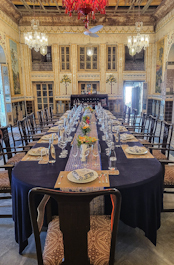
One of these Sherherwali bankers, Rai Bahadur Budh Sing Dudhoria, constructed a huge mansion, now known as ‘Bari Kothi’, close to the river Hooghly in what is now the small city of Azimganj (near Murshidabad). The huge edifice, which was restored a few years ago, is built around seven courtyards. It is lavishly decorated in a style that would have been familiar to the family when it was enjoying its heyday. Today, it is used as a luxurious ‘heritage’ hotel, which is famed for its Jain food.
When the banker, who lived at Bari Kothi, told the Nawab that he wanted to move away from Murshidabad because he lacked the company of fellow Jains, the ruler allotted land on both sides of the river to the Jain community, and told the banker to invite other Jains to make their homes there. 97 families arrived.
The combined wealth of the 30 or so Sherherwali families who settled in the Azimganj area was so great that it exceeded that of the entire English aristocracy. This was sometime before 1757, when the Nawab Siraj-ud-Daulah was defeated by the British at the Battle of Palashi (Plassey). After that, Bengal’s capital shifted to Kolkata, as did most of the Sherherwalis.
Bari Kothi was badly damaged during the Naxalite disturbances in the 1970s. It was beautifully restored under the supervision of the architect Dr Samar Chandra. We visited the place today (15 January 2025) and were shown around the maze of corridors, rooms, and courtyards. Our guide showed us parts of the building that are still undergoing careful restoration. What has already been restored and is used by hotel guests is superbly done. For those seeking a glorious ‘heritage’ experience, a few days at Bari Kothi will not be disappointing. However, for those hoping for a fried egg at breakfast time, this is most certainly not available.
January 18, 2025
Baked earth and building Islamic places of worship
THE COUNTRYSIDE AROUND Murshidabad is dotted with brick factories. Their tall, often smoking, chimneys are surrounded by vast expanses of new bricks, usually stacked neatly. The clay that can be found in the area is particularly good for brick making. So, it is unsurprising that many local buildings make substantial use of brickwork.
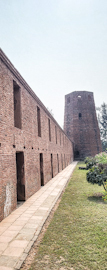 One of the towers of the Katra mosque
One of the towers of the Katra mosque Near Murshidabad, there are two famous mosques constructed not with stone or concrete, but with bricks. One of these, the Katra mosque, was constructed entirely with bricks between 1723 and 1724. This huge edifice was built not only as a mosque but also as a caravanserai. It is one of the largest caravanserais in the Indian Subcontinent. The rooms of the caravanserai are arranged in a square that surrounds the mosque rather like cloisters in a monastery. These small rooms also served as workplaces and bedrooms for students studying the Koran and other Islamic texts. Thus, the Katra was a complex consisting of a mosque, a caravanserai, and a madrasa. At each of its four corners, there were tall brick towers. Only two of these remain. The tomb of Nawab Murshid Quli Khan(1660-1727) is located under the staircase leading to the main entrance of the building. Protected by the Archaeological Survey of India, the remains of the Katra complex are well conserved. This is not the case for another brick mosque nearby: the Fauti Masjid.
The Fauti was constructed in 1740 by Nawab Safaraz Khan (c1700 – 1740). However, it was never completed. It is a large mosque, 137 feet long and 38 feet wide. If you manage to chamber within it, which I did with great difficulty despite helping hands, the remains of its five huge incomplete domes can be seen.
The Fauti is a protected building, but in a bad condition. It is possibly perilously unstable. However, because of the vegetation around it and within it, it is a picturesque ruin of the sort that eighteenth and nineteenth century European Romantic artists enjoyed portraying.
In addition to these mosques, which were built using baked clay (I.e., bricks), we have also seen some Hindu temples near Murshidabad that include terracotta in their construction. But more about these at a later date.
January 17, 2025
A white horse, which only works for a few days each year, grazes in Bengal
This white horse, grazing outside the Nizamat Imambara, which faces the Hazarduari Palace in Murshidabad, is only required to work during the few days of the Shia Muslim festival of Muharram.
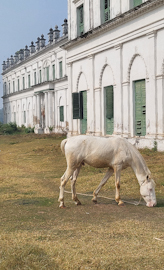
The Imambara is a Shia congregation hall, which was constructed in 1847. Only open during Muharram, it contains a shrine that houses soil brought from Mecca.
January 16, 2025
Defeated by the British who were helped by a traitor
THE MOTIJHEEL PARK in Murshidabad is a popular amusement park with a boating lake, a roller coaster, a restaurant, a miniature railway that carries passengers, and, surprisingly, a small museum.
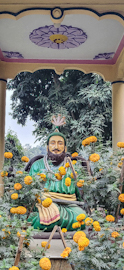 Siraj-ud-Daulah
Siraj-ud-Daulah The museum is dedicated to Siraj-ud-Daulah (1733-1757), who was the last independent Nawab of Bengal before the territory was conquered by the British East India Company’s army. There is also a statue of Siraj-ud-Daulah in the park.
His forces were defeated at the Battle of Palashi (Plassey) in 1757 by armies led by Robert Clive. Siraj-ud-Daulah lost the battle not least because Clive bribed Mir Jafar, who was Siraj-ud-Daulah’s Commander-in-Chief, to defect to the British. The defeat at Palashi was an important factor in allowing the British to conquer Bengal.
The dimly lit museum at Motijheel Park contains a series of information panels that give the viewer a simplified history of Siraj-ud-Daulah and the Battle of Palashi. Apart from these, there are a few other exhibits of no great significance.



